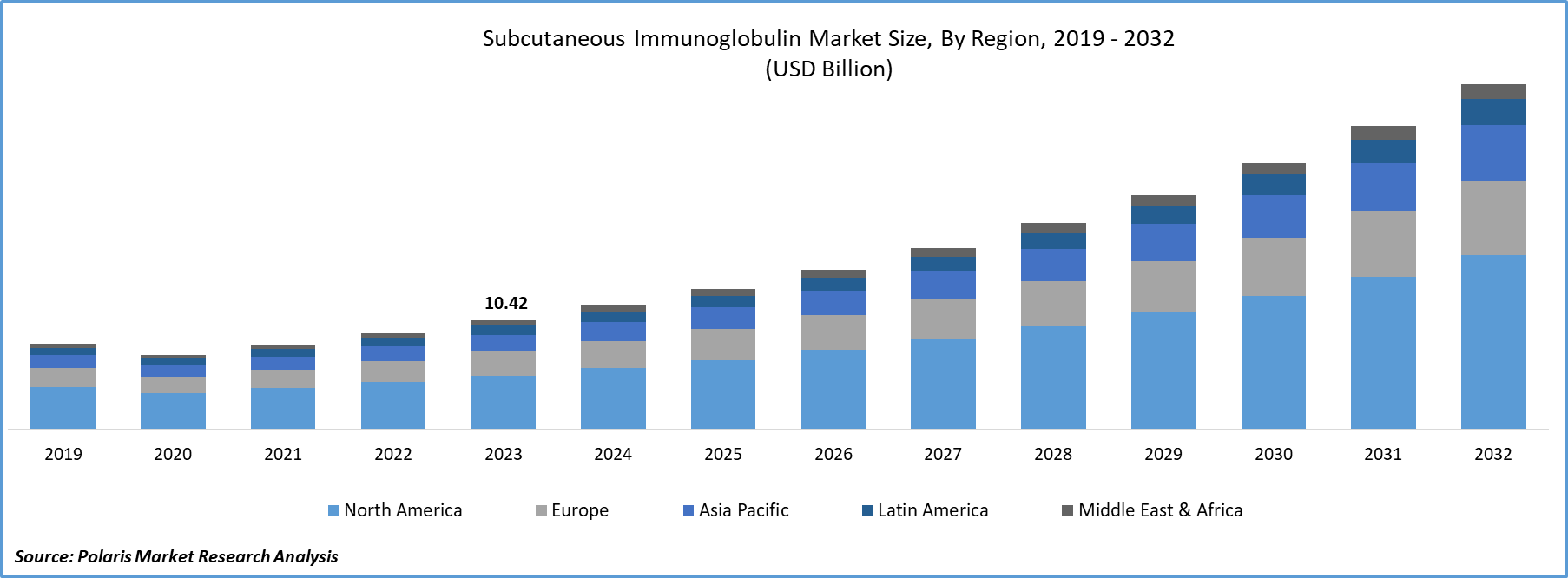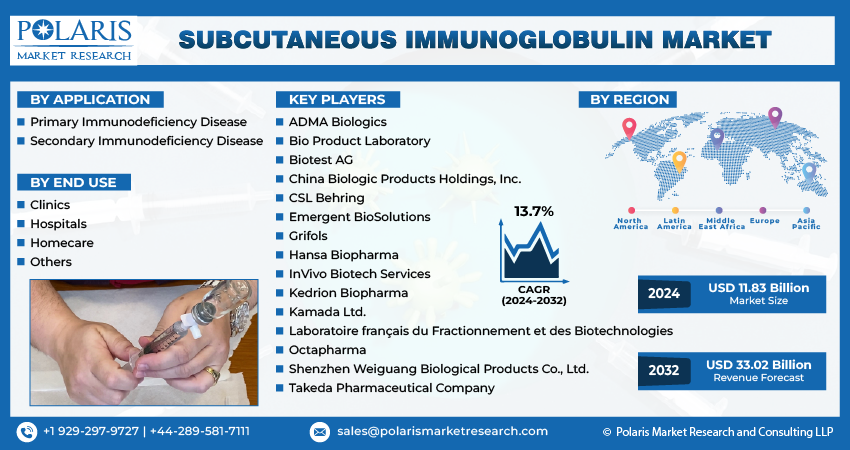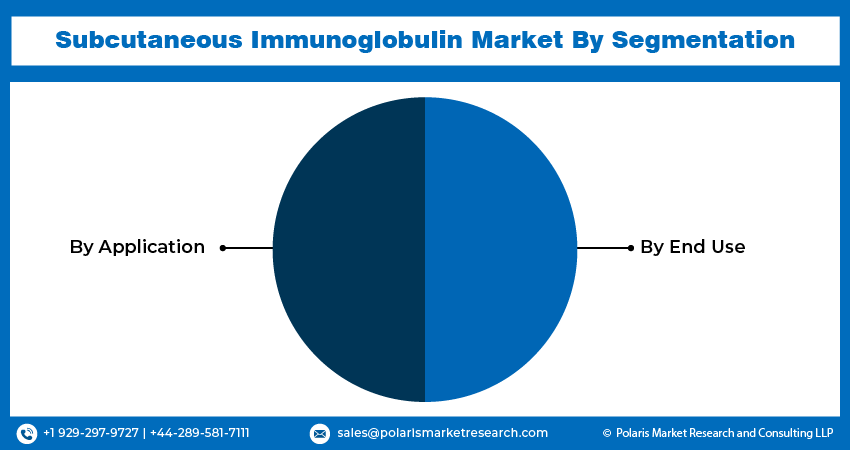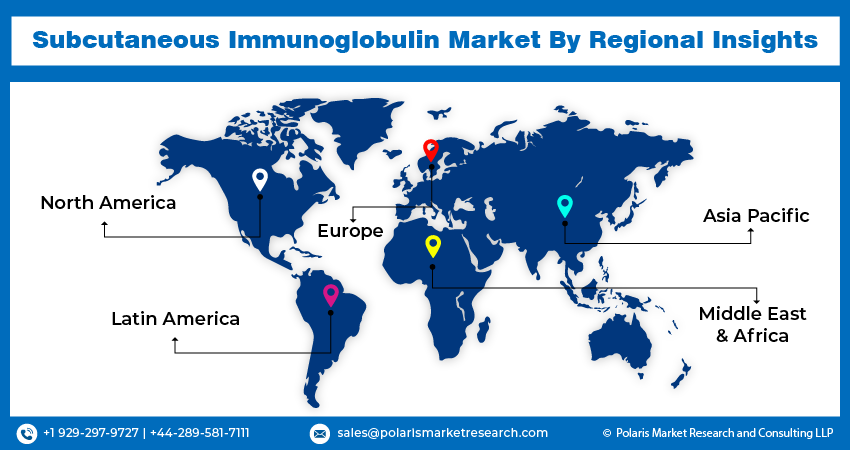
Subcutaneous Immunoglobulin Market Share, Size, Trends, Industry Analysis Report, By Application (Primary Immunodeficiency Disease, Secondary Immunodeficiency Disease); By End Use; By Region; Segment Forecast, 2024- 2032
- Published Date:Jan-2024
- Pages: 118
- Format: PDF
- Report ID: PM4416
- Base Year: 2023
- Historical Data: 2019 – 2022
Report Outlook
- Subcutaneous Immunoglobulin Market size was valued at USD 10.42 billion in 2023.
- The market is anticipated to grow from USD 11.83 billion in 2024 to USD 33.02 billion by 2032, exhibiting the CAGR of 13.7% during the forecast period.
Market Introduction
Rising global healthcare expenditure is driving substantial growth in the subcutaneous immunoglobulin market size. The increased financial commitment to healthcare aligns with the growing adoption of subcutaneous immunoglobulin for treating immunodeficiency disorders. The market benefits from the flexibility of subcutaneous administration, fitting into the broader trend of personalized and patient-centric healthcare approaches. This surge in healthcare spending facilitates greater investment in advanced therapies like subcutaneous immunoglobulin, offering patients more accessible and efficient treatment options and emphasizing a commitment to innovative solutions for immunodeficiency disorders.
In addition, companies operating in the market are being granted approvals for new solutions to cater to the growing market demand.
- For instance, in September 2023, Takeda reported that the approval from the Japanese Ministry of Health, Labour and Welfare was granted for the utilization of CUVITRU [Immune Globulin Subcutaneous (Human), 20% Solution] in individuals aged 2 years and above who are diagnosed with agammaglobulinemia or hypogammaglobulinemia.
Technological progress is propelling substantial growth in the subcutaneous immunoglobulin market share. Innovations in drug delivery, such as wearable infusion devices and autoinjectors, enhance administration, improving patient convenience and adherence. Manufacturing advancements yield highly purified and concentrated formulations, optimizing therapeutic results. Advanced diagnostics and monitoring technologies enable personalized treatment plans and real-time immunoglobulin level tracking. This evolving technology landscape is reshaping the market, promising improved efficacy, accessibility, and patient outcomes in the treatment of immunodeficiency disorders.

To Understand More About this Research: Request a Free Sample Report
Embracing a personalized healthcare approach, individualized dosing regimens and infusion schedules are gaining prominence, especially in response to patient-specific needs. Advanced diagnostic technologies enable precise assessment of immunoglobulin levels and immune system status, facilitating the customization of therapies. This personalized approach not only enhances treatment efficacy but also boosts patient satisfaction and adherence.
Industry Growth Drivers
- Increasing incidence of immunodeficiency disorders is projected to spur the product demand
The market is surging as immunodeficiency disorders become more prevalent. Conditions like primary and secondary immunodeficiency syndromes are fueling the demand. Patients with compromised immune systems require regular subcutaneous immunoglobulin infusions for immune system reinforcement. Its convenience compared to traditional intravenous methods is contributing to market growth. With increasing awareness of immunodeficiency disorders and improved diagnostics, the market is anticipated to meet the growing demand for accessible and effective immunoglobulin therapies.
- Patient-centric approach is expected to drive market growth
A patient-centric approach propels the market's growth. It is increasingly favored for treating immunodeficiency disorders, emphasizing patient experience. Subcutaneous administration allows convenient self-administration at home, enhancing flexibility and treatment adherence. This shift not only boosts satisfaction but also aligns with patient preferences, creating a more user-friendly treatment landscape. As the subcutaneous immunoglobulin market industry forecast expands, prioritizing patient-centric care becomes pivotal in shaping market dynamics, focusing on the comfort and autonomy of individuals undergoing immunoglobulin therapy.

Industry Challenges
- High cost of treatment is likely to impede the market growth
The market faces a significant impediment in the form of the high cost of treatment. This financial barrier, encompassing the expense of products and administration equipment, hinders its widespread adoption. Affordability concerns limit patient access, especially where insurance coverage is insufficient. The cost factor also influences healthcare providers' prescribing preferences, favoring more traditional and cost-effective treatments.
Report Segmentation
The subcutaneous immunoglobulin market analysis is primarily segmented based on application, end use, and region.
|
By Application |
By End Use |
By Region |
|
|
|
To Understand the Scope of this Report: Speak to Analyst
By Application Analysis
Primary immunodeficiency disease segment accounted for significant market share in 2023
The primary immunodeficiency disease segment accounted for a significant market share in 2023. Subcutaneous immunoglobulin emerges as a patient-centric solution for primary immunodeficiency, revolutionizing treatment dynamics. Enabling home-based administration, subcutaneous immunoglobulin empowers patients with self-administration options, reducing the reliance on hospital visits and fostering independence. Its flexible treatment schedule, featuring customized dosing regimens, caters to individual preferences and lifestyles. Subcutaneous immunoglobulin ensures a steady supply of immunoglobulins, maintaining stable antibody levels and thereby proactively defending against infections. With minimal systemic side effects, it enhances patient satisfaction, offering a well-tolerated and accessible alternative.
By End Use Analysis
Hospital segment held significant market revenue share in 2023
The hospital segment held a significant revenue share in 2023. Hospitals utilize subcutaneous immunoglobulin across diverse medical contexts. In treating primary immunodeficiency disorders, subcutaneous immunoglobulin compensates for inadequate antibody production, fortifying compromised immune systems. For neurological conditions like Chronic Inflammatory Demyelinating Polyneuropathy (CIDP), subcutaneous immunoglobulin offers targeted immune modulation in hospital settings. In autoimmune disorders, subcutaneous immunoglobulin regulates immune responses against healthy tissues. Post-transplant care incorporates subcutaneous immunoglobulin to support immune recovery. It manages acute infections efficiently, and in pediatric immunodeficiency, it provides tailored antibody replacement. Hospitals extend their role by educating patients on home-based subcutaneous immunoglobulin administration, ensuring safe and independent treatment. Rapid push infusions enhance efficiency, outpatient clinics ensure continuity and collaborative care teams tailor subcutaneous immunoglobulin plans, illustrating its versatility in hospital care.

Regional Insights
North America region dominated the global market in 2023
In 2023, the North American region dominated the global market. The market thrives on rising immunodeficiency disorders. Technological innovations in formulations and delivery methods enhance efficacy while growing awareness among patients and healthcare providers propels market momentum. Increasing healthcare expenditure reflects recognition of its clinical value, and regulatory approvals expand treatment choices. Patient-centric care promotes SCIG's convenience, fostering wider adoption. The competitive landscape involves both established and emerging players, encouraging innovation. Collaborations drive research, insurance coverage influences access, and the COVID-19 impact underscores its critical role in immune-related conditions, highlighting sector adaptability.
Over the projected period, the Asia-Pacific region is likely to experience significant growth. The subcutaneous immunoglobulin industry in Asia-Pacific experiences notable growth, particularly in emerging economies. Increasing healthcare access and rising awareness of immunodeficiency disorders contribute to market expansion. Asia's prominence in medical tourism influences the industry, with patients seeking advanced immunoglobulin therapies. This trend contributes to the growth of specialized healthcare facilities in the region.

Key Market Players & Competitive Insights
Diverse participants characterize the subcutaneous immunoglobulin market size, and the expected influx of numerous newcomers is poised to heighten competitive dynamics. Established industry leaders consistently enhance their technologies to maintain a competitive advantage, emphasizing efficiency, integrity, and safety. These entities prioritize strategic endeavors such as forging partnerships, improving products, and participating in collaborative ventures to surpass their counterparts. Their goal is to secure a substantial subcutaneous immunoglobulin market share.
Some of the major players operating in the global subcutaneous immunoglobulin market include:
- ADMA Biologics
- Bio Product Laboratory
- Biotest AG
- China Biologic Products Holdings, Inc.
- CSL Behring
- Emergent BioSolutions
- Grifols
- Hansa Biopharma
- InVivo Biotech Services
- Kedrion Biopharma
- Kamada Ltd.
- Laboratoire français du Fractionnement et des Biotechnologies
- Octapharma
- Shenzhen Weiguang Biological Products Co., Ltd.
- Takeda Pharmaceutical Company
Recent Developments
- In January 2024, CSL Behring introduced a 10g prefilled syringe option for Hizentra (Immune Globulin Subcutaneous [Human] 20% Liquid). This advancement in Hizentra's offerings benefits individuals coping with Primary Immunodeficiency (PI) and Chronic Inflammatory Demyelinating Polyneuropathy (CIDP) by enhancing their treatment experience. The prefilled syringes eliminate the requirement to draw medication from vials, providing a more convenient and streamlined administration process for patients.
- In April 2023, Takeda revealed that the U.S. Food and Drug Administration (FDA) granted approval for a supplemental biologics license application (sBLA), expanding the application of HYQVIA to address primary immunodeficiency (PI) in the pediatric population aged 2-16 years.
Report Coverage
The market report emphasizes on key regions across the globe to provide better understanding of the product to the users. Also, the report provides market insights into recent developments, trends and analyzes the technologies that are gaining traction around the globe. Furthermore, the report covers in-depth qualitative analysis pertaining to various paradigm shifts associated with the transformation of these solutions.
The report provides detailed analysis of the market while focusing on various key aspects such as competitive analysis, applications, end uses, and their futuristic growth opportunities.
Subcutaneous Immunoglobulin Market Report Scope
|
Report Attributes |
Details |
|
Market size value in 2024 |
USD 11.83 billion |
|
Revenue forecast in 2032 |
USD 33.02 billion |
|
CAGR |
13.7% from 2024 – 2032 |
|
Base year |
2023 |
|
Historical data |
2019 – 2022 |
|
Forecast period |
2024 – 2032 |
|
Quantitative units |
Revenue in USD billion and CAGR from 2024 to 2032 |
|
Segments covered |
|
|
Regional scope |
|
|
Competitive Landscape |
|
|
Report Format |
|
|
Customization |
Report customization as per your requirements with respect to countries, region and segmentation. |
FAQ's
The global Subcutaneous Immunoglobulin market size is expected to reach USD 33.02 billion by 2032
Key players in the market are Bio Product Laboratory, Biotest AG, CSL Behring, Grifols, Laboratoire français du Fractionnement et des Biotechnologies
North America contribute notably towards the global Subcutaneous Immunoglobulin Market
Subcutaneous Immunoglobulin Market exhibiting the CAGR of 13.7% during the forecast period.
The Subcutaneous Immunoglobulin Market report covering key segments are application, end use, and region.
